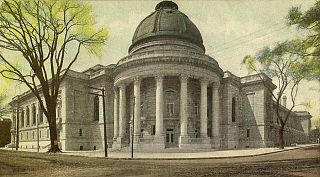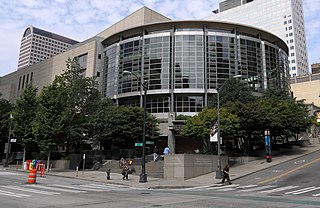
Symphony Hall is a concert hall that is home to the Boston Symphony Orchestra, located at 301 Massachusetts Avenue in Boston, Massachusetts. BSO founder Henry Lee Higginson commissioned architectural firm McKim, Mead and White to create a new, permanent home for the orchestra. Symphony Hall can accommodate an audience of 2,625. The hall was designated a U.S. National Historic Landmark in 1999 and is a pending Boston Landmark. It was then noted that "Symphony Hall remains, acoustically, among the top three concert halls in the world, and is considered the finest in the United States." Symphony Hall, located one block from Berklee College of Music to the north and one block from the New England Conservatory to the south, also serves as home to the Boston Pops as well as the site of many concerts of the Handel and Haydn Society.

Symphony Hall is a 2,262 seat concert venue in Birmingham, England. It was officially opened by Queen Elizabeth II on 12 June 1991, although it had been in use since 15 April 1991. It is home to the City of Birmingham Symphony Orchestra and hosts around 270 events a year. It was completed at a cost of £30 million. The hall's interior is modelled on the Musikverein in Vienna and the Concertgebouw in Amsterdam. The venue, managed alongside Town Hall, presents a programme of jazz, world, folk, rock, pop and classical concerts, organ recitals, spoken word, dance, comedy, educational and community performances, and is also used for conferences and business events as part of the International Convention Centre.

The Walt Disney Concert Hall at 111 South Grand Avenue in downtown Los Angeles, California, is the fourth hall of the Los Angeles Music Center and was designed by Frank Gehry. It was opened on October 23, 2003. Bounded by Hope Street, Grand Avenue, and 1st and 2nd Streets, it seats 2,265 people and serves, among other purposes, as the home of the Los Angeles Philharmonic orchestra and the Los Angeles Master Chorale. The hall is a compromise between a vineyard-style seating configuration, like the Berliner Philharmonie by Hans Scharoun, and a classical shoebox design like the Vienna Musikverein or the Boston Symphony Hall.

The John F. Kennedy Center for the Performing Arts is the United States National Cultural Center, located on the eastern bank of the Potomac River in Washington, D.C. It was named in 1964 as a memorial to assassinated President John F. Kennedy. Opened on September 8, 1971, the center hosts many different genres of performance art, such as theater, dance, orchestras, jazz, pop, psychedelic, and folk music.

Orchestra Hall is a concert hall that is located on 11th Street at Peavey Plaza in downtown Minneapolis, Minnesota. The home of the Minnesota Orchestra, it is a major landmark of the southern portion of Nicollet Mall and hosts many events throughout the year, in addition to being the Orchestra's home.

The Morton H. Meyerson Symphony Center is a concert hall located in the Arts District of downtown Dallas, Texas, US. Ranked one of the world's greatest orchestra halls, it was designed by architect I. M. Pei and acoustician Russell Johnson's Artec Consultants. The structural engineers for this project was Leslie E. Robertson Associates, and it opened in September 1989.

David Geffen Hall is a concert hall at Lincoln Center on the Upper West Side of Manhattan in New York City. The 2,200-seat auditorium opened in 1962, and is the home of the New York Philharmonic.

Massey Hall is a performing arts theatre in Toronto, Ontario, Canada. Opened in 1894, it is known for its outstanding acoustics and was the long-time hall of the Toronto Symphony Orchestra. An intimate theatre, it was originally designed to seat 3,500 patrons, but after extensive renovations in the 1940s, it now seats only up to 2,765. It has an extensive history of concerts by artists of many musical genres which continues today.

Woolsey Hall is the primary auditorium at Yale University, located on the campus' Hewitt Quadrangle in New Haven, Connecticut. It was built as part of the Bicentennial Buildings complex that includes the Memorial Rotunda and the University Commons for the Yale bicentennial celebration in 1901, and was designed by the Beaux-Arts architectural firm Carrère and Hastings. With approximately 2,650 seats, it is the university's largest auditorium and hosts concerts, performances, and university ceremonies including the annual freshman convocation, senior baccalaureate, and presidential inaugurations. The building is named for Theodore Dwight Woolsey, President of Yale from 1846 through 1871.

Benaroya Hall is the home of the Seattle Symphony in Downtown Seattle, Washington, United States. It features two auditoria, the S. Mark Taper Foundation Auditorium, a 2,500-seat performance venue, as well as the Illsley Ball Nordstrom Recital Hall, which seats 536. Opened in September 1998 at a cost of $120 million, Benaroya is noted for its technology-infused acoustics designed by Cyril Harris. Benaroya occupies an entire city block in the center of the city and has helped double the Seattle Symphony's budget and number of performances. The lobby of the hall features a large contribution of glass art, such as one given the title Crystal Cascade, by world-renowned artist Dale Chihuly.

Hill Auditorium is the largest performance venue on the University of Michigan campus, in Ann Arbor, Michigan. The auditorium was named in honor of Arthur Hill (1847–1909), who served as a regent of the university from 1901 to 1909. He bequeathed $200,000 to the university for the construction of a venue for lectures, musical performances, and other large productions. Opened in 1913, the auditorium was designed by Albert Kahn and Associates. It was renovated by the same firm beginning in 2002 and was re-opened in 2004.

The Suntory Hall (サントリーホール) is a concert venue in the central Akasaka district of Tokyo, Japan. Part of the Ark Hills complex, it consists of a main concert hall, widely considered one of the finest in the world for its acoustics – Herbert von Karajan called it “a jewel box of sound” – and a smaller side-hall for chamber music. Its roof is an extended, tiered, landscape garden. Construction began in the late 1970s and the facility opened in October 1986.

The Krannert Center for the Performing Arts is an educational and performing arts complex located at 500 South Goodwin Avenue in Urbana, Illinois and on the campus of the University of Illinois Urbana-Champaign. Herman C. Krannert, an industrialist who founded Inland Container Corporation and an alumnus of the university, and his wife, Ellnora Krannert, made a gift of $16 million that led to the Krannert Center's construction. Max Abramovitz, the architect who designed the facility, was also an Illinois alumnus.

The Perth Concert Hall is a concert hall located in Perth, the capital of the Australian state of Western Australia. Owned by the City of Perth, the hall is the main venue of the West Australian Symphony Orchestra, and also hosts a number of other events and performances. The building itself is located in Perth's central business district, adjacent to the Supreme Court Gardens and Government House. The building has two façades: facing north over St Georges Terrace, and facing south over the Swan River.

Royce Hall is a building on the campus of the University of California, Los Angeles (UCLA). Designed by the Los Angeles firm of Allison & Allison and completed in 1929, it is one of the four original buildings on UCLA's Westwood campus and has come to be the defining image of the university. The brick and tile building is in the Lombard Romanesque style, and once functioned as the main classroom facility of the university and symbolized its academic and cultural aspirations. Today, the twin-towered front remains the best known UCLA landmark. The 1800-seat auditorium was designed for speech acoustics and not for music; by 1982 it emerged from successive remodelings as a regionally important concert hall and main performing arts facility of the university.

Bilkent Concert Hall is a performing arts center in Turkey. It is located within the Bilkent University campus in Ankara. Home to the Bilkent Symphony Orchestra, the building hosts over 80 concerts per year. Besides the concert hall itself, the building houses seminar rooms, academic staff offices, classrooms and studios for the university's Faculty of Music and Performance Arts, together with an arena theatre for performances from theatre studies students.

The Helsinki Music Centre is a concert hall and a music center in Töölönlahti, Helsinki. The building is home to Sibelius Academy and two symphony orchestras, the Finnish Radio Symphony Orchestra and the Helsinki Philharmonic Orchestra.

Symphony Silicon Valley is the professional symphony orchestra of San Jose and the South Bay region of the San Francisco Bay Area. Founded in 2002 following the demise of the San Jose Symphony, the orchestra debuted to rave reviews and standing ovations on November 23, 2002 at the San Jose Center for the Performing Arts. Started initially by Ballet San Jose as a way to keep their core musicians employed and in town after the closure of the San Jose Symphony, the orchestra was so successful that it was spun off as its own separate nonprofit organization after the first year.

The Conrad Prebys Music Center (CPMC) is a music center in La Jolla, California, located on the campus of the University of California, San Diego. It houses the university's music department, and is anchored by the 400-seat Concert Hall, in addition to the 170-seat Recital Hall and an Experimental Theatre with a variable digital acoustics system.

The Conrad Prebys Performing Arts Center, also known as The Conrad, is a concert hall in La Jolla, a community of San Diego, California. It was opened in April 2019 and serves as the permanent residence of the La Jolla Music Society.





















